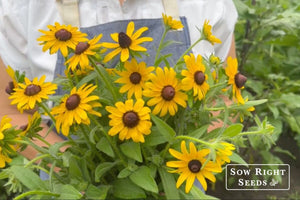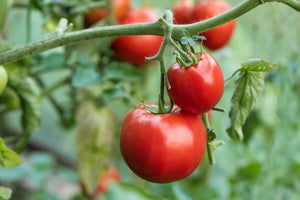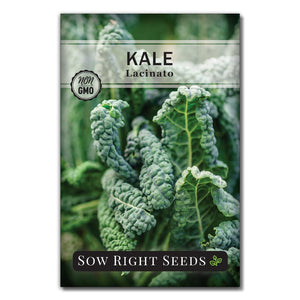3 Reasons You'll Want to Plant and Grow Swiss Chard in Your Garden
Leafy greensSwiss Chard (Beta vulgaris) is one of the healthiest vegetables and also one of the easiest to grow. It is a beautiful plant that can be tucked in with your flowers for an edible landscape. Chard can be eaten raw or cooked and is a tasty substitute for spinach or kale. Continue reading to see how easy it is to grow Swiss Chard from seed for a delicious harvest.

Why Grow Swiss Chard
Here are our three favorite reasons to grow Swiss chard plants.
Easy to Grow
If you are new to gardening, Swiss chard is an excellent vegetable to start with. With well-draining, nutrient-rich soil, it will flourish without any hard work. It can even be grown in a pot on a sunny balcony.
Incredibly Healthy Vegetable
The nutrition benefits alone are enough to justify garden space for this vegetable. Swiss chard is an excellent source of B vitamins as well as A, C, E, and K. It is rich in Magnesium, Manganese, Potassium, Iron, Calcium, Copper, and Dietary Fiber. You’ll boost your health with low-calorie, nutrient-dense Swiss chard.
Aesthetic
The full foliage and colorful stems of Swiss Chard make it a beautiful plant in all kinds of landscapes. It can be grown with your flowers as well as a traditional garden plot. From early spring until the first winter freeze, it will add visual interest to your growing space.
How to Grow Swiss Chard from Seed
Starting Swiss chard from seed is simple to do. You can sow Swiss chard directly in the ground outdoors or start seeds indoors.
For spring planting, start seeds indoors 6 to 8 weeks before the last spring frost. Or direct sow outside 3 to 4 weeks before the last spring frost.
For fall gardens, give Swiss chard 50 to 60 days to mature before the first fall frost. It will be able to tolerate the cooler temperatures and will continue growing until winter.
Starting Swiss Chard Seeds Indoors
Plant 1 to 2 chard seeds ½” deep in moist seed starting mix.
Use supplemental heat for the best germination. 65º to 80ºF is ideal.
Keep seeds moist until they start sprouting in 7 to 14 days.
Water young Swiss chard sprouts from the bottom to prevent fungus and damping off.
Keep grow lights close to the plants to keep them from becoming spindly when they stretch toward the light.
Seedlings are ready to be transplanted when they are at least 2 inches tall and have four or more true leaves.
Sowing Swiss Chard Seeds Outdoors
Swiss chard seeds can be sown directly into the ground. The seeds will germinate when the soil temperature is warm enough, usually above 50ºF. If the soil is dry, water the ground before planting the seeds. Cover the chard seeds with ½” of soil and keep them moist.
Succession planting will space out your harvest. You can continue sowing seeds every 10 to 14 days for a continual summer harvest.

Transplanting Swiss Chard Seedlings
Once seedlings are 2 inches tall and have at least four true leaves, they will be ready for transplanting. Start acclimating your Swiss chard seedlings to their bright outdoor life by hardening them off. This process will help them ease into the transition without transplant shock.
Plant Swiss chard seedlings in a sunny spot with fertile, well-draining soil. If needed, amend the soil with well-rotted compost before transplanting. Space plants 12” apart and 18” apart in rows. Swiss chard can be closer together if you are mainly harvesting baby leaves. More space is needed if you want larger leaves.

Growing Swiss Chard
Maintaining Swiss chard in your garden is very simple. Keep the area weed-free and well-watered.
Soil:
Swiss chard will grow best in moist, nutrient-rich soil. A soil test can tell you if there needs to be any amendments before planting. Compost and organic matter will create a fertile, loamy soil that rains well.
Sun:
Full sun is recommended for growing Swiss chard plants. Although it will tolerate some shade, it needs lots of sun to grow those nutrient-dense leaves.
Water:
Consistent watering of about 1 inch a week is needed. The soil should stay moist without being waterlogged. Using mulch can help keep the moisture from evaporating. But keep mulch away from the base of the Swiss chard plants.
Harvesting Swiss Chard
Swiss chard takes about two months from seed to harvest. You can start harvesting Swiss chard when the leaves are about 3” long. You can break off individual leaves and leave the center core to keep producing. If desired, you can cut the whole bunch at once. Cut with a sharp knife one inch above the soil, and it will grow new leaves.
Harvest Swiss chard in the morning when the leaves are crisp. In the heat of the sun, the leaves will wilt.
Smaller leaves will be more tender and less bitter. They are excellent for using fresh. Larger leaves will be better for cooking.
Harvested Swiss chard is best when eaten on the same day. But it can be stored in the fridge for up to a week. Wait to wash Swiss chard until right before using it for better storage.
The use of row covers can protect Swiss chard from freezing and extend the fall harvest. Mature plants can withstand temperatures around 25ºF. Row covers and tunnels can increase the temperature by 10 degrees.

Overwintering Swiss Chard Plants
Swiss chard is a biennial plant and can regrow in spring, even in cold climates. To overwinter Swiss chard, protect the crown with straw and cover with a frost cloth.
In the spring, new leaves will emerge. Once these new leaves have been harvested, the Swiss chard plants will want to flower and go to seed. This is the perfect time to pull out the old plants and put in your new spring crop.
Swiss Chard FAQs
Does Swiss Chard Come Back?
Swiss chard is a biennial, which means it will grow for two years. This allows you to harvest in one season, and it will produce new leaves. New leaves will emerge in the spring when the chard plant dies back in the winter. After this second harvest, the plant will be done producing fresh leaves and will go to seed. This is the perfect time to plant new seeds.
Can Swiss chard be grown in containers?
Containers at least 16” deep and wide are excellent for growing Swiss chard. Keep container plants in a sunny location and water them well for a reliable harvest.
What’s the healthiest way to cook Swiss chard?
Slice leaves into 1” strips and stems into ½” pieces. Cook chard in boiling water for 3 minutes. Cooking too long will destroy a significant amount of nutrients.
Swiss chard is an easy-to-grow, leafy green vegetable that is ready to become your favorite. It will add beauty to the landscape and provide you with one of the healthiest plants you can eat. Choose reliable seeds and start growing Swiss chard in your garden.
Found this information helpful? Share it with your gardening friends!






Leave a comment